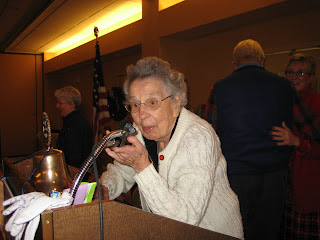
Imagine you are 99 years old and in a few days you’ll be turning 100. Teddy Roosevelt was president when you were born, 50 years ago you were 50, and you drove a car until you were 97.
Far-fetched? Read on.
Now you’re seated at a luncheon with tables of people who’ve gathered to make a fuss over your birthday and the birthday of another nearly 100-year-old woman.
While she’s not in attendance, you are, and in a moment you’ll be asked to stand and speak.
At nearly 100 years, what could you possibly say to sum up your life?
Keep reading to discover what Dr. Grace Devnich said to some 125 Rotarians who gathered last week to celebrate her 100 years and the 100 years of Henrietta Greer, both of Livermore.
While Greer was unable to attend, Devnich was on hand as several eloquent individuals spoke about her and Greer.
Local historian Anne Homan provided an overview of the era when the women were born, a time before television, radios, or movies. Homan touched on the lives of Devnich and Greer, which led into remarks by former Livermore mayor Dr. John Shirley who provided a wonderful introduction of Devnich, Livermore’s first woman doctor.
“Grace delivered 800 babies,” said Dr. Shirley, “and for many years she only charged $125 for prenatal care and the delivery,” he said.
Dr. Shirley said that Devnich and her husband, Henry, who was also a doctor, came to Livermore in 1948 to set up their practice. Devnich still lives in the house they bought on K Street in 1952.
Born in Colorado, Devnich first attended Union College in Nebraska, where she met Henry in 1929. In time, the couple saved enough money to attend medical school at the University of Nebraska, graduating in 1945.
The two practiced medicine for more than three decades in Livermore, made house calls that initially cost just three dollars, and touched the lives of thousands of people. Shirley reminisced about the birth of his own four children through Devnich’s caring hands.
In 1992, Devnich lost Henry to a brain aneurysm, but not before the couple spent 16 years together in retirement, traveling and enjoying their golden years.
More recently, Devnich has become an author, having written a book about her husband’s family.
Similarly, though she was absent, Henrietta Greer and her life were introduced by Bill Nebo, who said that Greer’s family first arrived in Livermore in 1936 and settled onto a dairy farm out on Patterson Pass Road. Greer met her future husband, Tom, when he reported for work at the ranch after a San Francisco employment agency had placed the former Colorado cowboy in Livermore.
Nebo told a funny story about when Tom was struggling to coax a rambunctious mare into a corral. Greer watched for a while, then suggested she might help.
“If you can get this mare into the corral,” Tom told her, “I’ll give you five bucks.”
At the time, five dollars was a lot of money, and Greer simply opened the corral gate and called, “Tessie, get in here!”
The mare quietly did as she was told. Tom never paid her the five dollars, Nebo said, but he did marry her.
Nebo, who met Greer in 1972 and calls her his adopted mother, said that Greer is a woman who knows the difference between what one wants and what one needs, a woman who values companionship and relationship, who respects people of all age groups, and who understands the need for balance between work and enjoyment.
“For a woman who mended many cattle fences over the years,” Nebo said, “Henrietta is a woman with very few fences in her life. She accepts people for who they are and sees the best in them.”
After the introduction, when it came time for Devnich to stand and address the assembled Rotarians and guests, everyone stood and applauded. Devnich slowly made her way to the lectern, and as she reached for the microphone, the moment became emotional.
“I’ve had a wonderful life,” she said, “but I just can’t speak about it or I might begin to cry.”
And with that, she returned to her seat to thunderous applause.
With those few words, Devnich summed up 100 years of giving and receiving, of births and deaths, of healing and loss, of happiness, and yes, of joyful tears.

Dr. Grace Devnich spoke only for a moment, but her words filled the Livermore Rotarians with great joy.



































